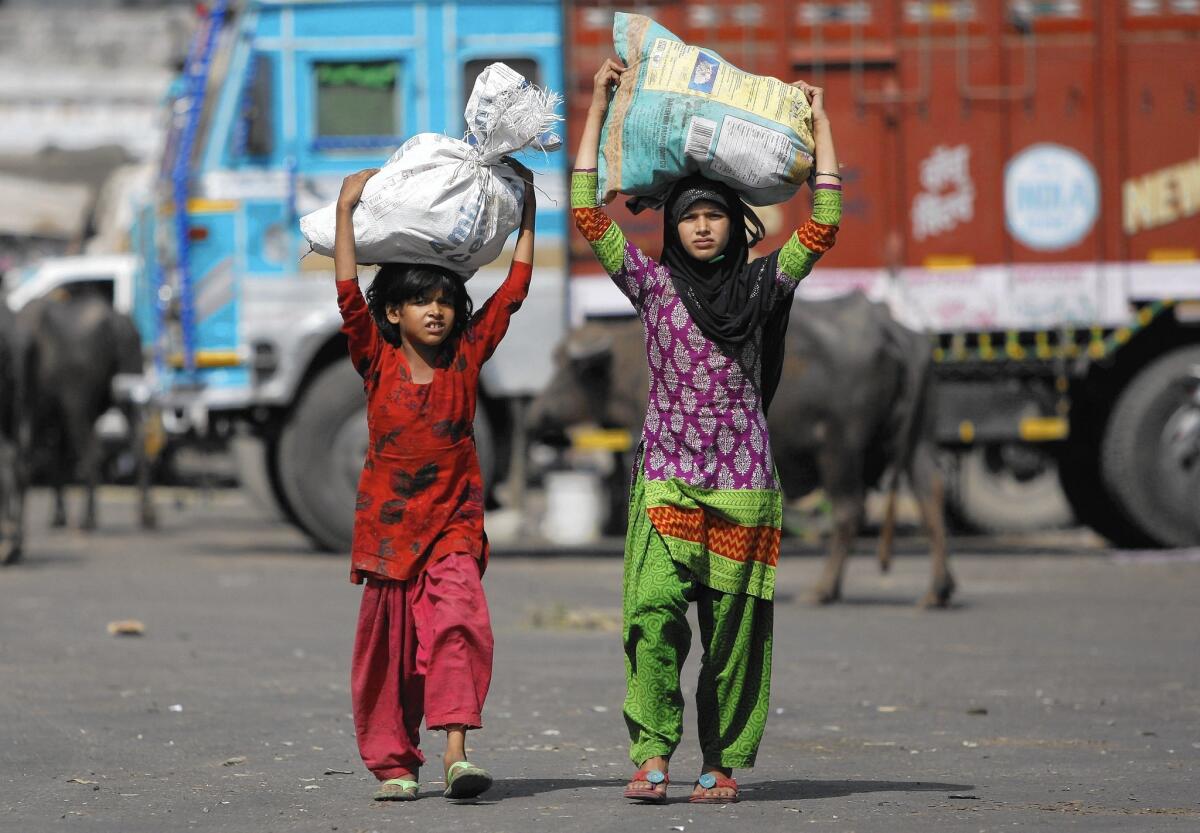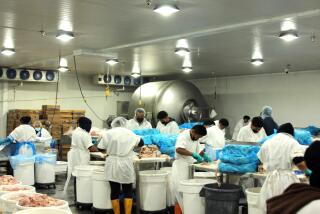Does India’s new ‘Make in India’ campaign mean ‘Made by Children?’

Reporting from Surat, India — Their hands fly with the speed and precision of veteran assembly-line workers, pausing only to flick sweat from their shiny-smooth foreheads.
They construct box after cardboard box, designed for sari shops in far-off cities, stacking them into multi-hued towers that loom above their small, hunched bodies.
Many of the workers are not yet teenagers, and they fill the dimly lighted corridors of the textile mills and warehouses of this industrial city in western India. Despite a law requiring every child younger than 14 to be in school full time, millions of Indian boys and girls still hold jobs, including more than 50,000 in Surat alone, according to estimates by human rights groups.
India has declared that it wants to end child labor, but advocacy groups argue that a new government proposal could actually push more youngsters into the workforce, jeopardizing their education and putting them at greater risk of exploitation.
Prime Minister Narendra Modi’s Cabinet last month approved amendments to a 3-decade-old child labor law that would make it legal to employ children younger than 14 in “family enterprises” not deemed hazardous.
Children would be barred from mining, heavy industry, manufacturing fireworks or other dangerous professions, but could participate in virtually any other sector as long as the work was outside school hours in a business run by relatives, says a government statement on the legislation.
Modi’s conservative government said it was seeking to strike “a balance between the need for education for a child and the reality of the socioeconomic condition and social fabric in the country.”
In many poor Indian families, boys and girls assist their parents from an early age, and proponents say an outright ban on child labor could harm small farmers, shopkeepers, cooks and others who rely on young hands to help them scrape by.
The number of recognized child laborers in India has fallen sharply, according to census data, to 4.3 million in 2011 from 12.6 million in 2001, although children working in family businesses are believed to be significantly undercounted. Child rights advocates are concerned that the government proposal could roll back even those gains by carving out a loophole that would be abused by employers who already stretch the definition of the word “family.”
In Surat, a fast-growing city of 4.6 million, textile bosses routinely tell labor inspectors that the boys embroidering saris, folding garments and assembling boxes are relatives.
Government surveys, however, indicate that many child workers in Surat are migrants from poorer states. Experts say the children rarely dare contradict their bosses and authorities often lack the resources or willingness to investigate further.
“Family business sounds good, but what we have found is that bosses say, ‘I’m his uncle’ or ‘he’s my son,’ and law enforcement is not very keen to verify the claim,” said Chandrashekhar Deshmukh, head of the nonprofit Pratham Council for Vulnerable Children’s office in Surat.
“If this practice gets legal cover, child labor might actually increase.”
Indian authorities are trying to bring child labor provisions in line with a landmark 2009 law that mandates free, full-time schooling for every boy and girl younger than 14. The earlier labor legislation banned children younger than 14 from working in only hazardous industries.
The amendments must win approval of both houses of Parliament and the largely ceremonial president, but analysts say they stand a good chance of becoming law.
Trade unions back the initiative, saying it is in line with International Labor Organization conventions that require countries to set a minimum working age of at least 14 and bar employment that would damage children’s health or well-being.
“It’s a very progressive amendment, and it is very clear,” said Vrijesh Upadhyay, general secretary of Bharatiya Mazdoor Sangh, India’s largest labor union.
“Suppose I am a shopkeeper. My child comes after school and sits with me, he helps me — that’s allowed. If in any way he earns money, that is child labor and that will be punished.”
The proposal stiffens penalties for employers found breaking the law to up two years in prison and a fine of about $800 for a first offense. But it scraps first-time punishments for parents, a nod to the struggles that prompt child labor to begin with.
Educators say that any regular work that takes away from children’s time to study or play outside of school can be harmful to their development and raise dropout rates. Farm work exposes children to harmful pesticides, and in Surat’s garment industry, which manufactures saris and other traditional clothing sold across India, children work all-day shifts for as little as $1.50.
One recent afternoon, trooping through the corridors of Shiv Shakti Textile Market in central Surat, social worker Meena Desale of the Pratham organization knelt and gently cupped the chin of a worker who looked no older than 10. His name was Amar, he said, smiling sheepishly as he folded a stretch of bright red fabric.
“Are you in school?” Desale asked.
“Yes,” came the reply. But when asked to name the school, Amar hesitated. He went silent and returned to his work.
“They are told to say this is only after-school work, to conform to the laws,” Desale said afterward. “But very few of them can read or write.”
The day after Surat authorities raided a restaurant last month, two teenage workers from the northern state of Rajasthan sat quietly in the administrator’s office at a government-run children’s home. One of them, Mahinder Rajaram, who is from a small village, said he had served tea and snacks for two months, earning about $35 each month.
Ramesh Khadsalia, a teacher at the home, said officials were trying to contact the boy’s family to send him home. But Khadsalia said there was a good chance that Mahinder, who said he had dropped out of school in fourth grade and did not know his age, would leave again to find work somewhere else.
Critics say the amendments send the wrong signal from Modi’s government, which has been trying to revive India’s lumbering manufacturing sector and promote foreign investment through a glossy campaign dubbed “Make in India.”
“There is a feeling that if children are blocked from working, the garment industry or other industry might suffer,” said Prabhat Kumar, child protection manager for the international charity Save the Children.
“But if you really look at the issue, this won’t be the case. No one would support the idea of ‘Make in India’ meaning ‘Made by Children.’”
More to Read
Sign up for Essential California
The most important California stories and recommendations in your inbox every morning.
You may occasionally receive promotional content from the Los Angeles Times.










